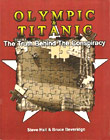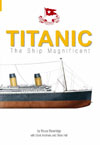|
| To Search This Site Enter Key Words Into Text Field On The Right and Hit The Search Button |
|
|
Steve Hall & Bruce Beveridge.
 |
Winner of the Titanic Book of the Year Award for 2004.
Hall, Steve & Bruce Beveridge. Titanic and Olympic, The Truth Behind the Conspiracy. 1st printing. Haverford, PA: Infinity Publishing. January, 2004. wraps. isbn: 0741419491. scarcity: hard to find.
After you have read a hundred+ or more Titanic books, a lot of information begins to become very familiar, as it is repeated to various degrees over and over again. There is nothing wrong with this as each new author often brings their own fresh approach to the story. Still, every once in while, a book comes along with completely original research, and when that happens, it is very exciting. Hall & Beveridge’s book is definitely the latter type, one of those rare books that offers details never revealed before. Before we get to the specifics though, here is a general outline of what this book is all about.
The primary purpose of this book is a comprehensive rebuttal to the infamous conspiracy theory first proposed in 1995 by Robin Gardiner and Dan van der Vat, that Olympic and Titanic were switched, and Olympic sunk on purpose in Titanic’s place. The reason, to collect the insurance money after Olympic had been damaged by her collision with the warship Hawke. The primary defense of this theory is Gardiner’s argument that, except for the Titanic’s A deck promenade windows, she was virtually identical to her sister ship, the Olympic.
Hall & Beveridge set out to disprove this conspiracy in an unusual way. They first attempt to amass the best defense for this theory as they can muster. But before they get to that portion of the book, there are several introductory chapters covering the basics about these vessels. Chapter one covers the design and technical specifications that were common to all the Olympic class ships. It shows how the ships were indeed similar in plan in very many ways.
Chapter two covers the construction phase of both Olympic and Titanic. This section also details some of the earlier problems with Olympic, like the lost propeller blade incident, and her collision with the warship Hawke. Both events ended up delaying work on Titanic. This chapter also has some very unique photo footage of the two ships during similar points in their construction. The images of the two ships are shown side by side so you can see, for example, the image of Olympic’s launch right next to one of Titanic’s launch. This is a very clever device which has not been used before.
Chapter three covers the Olympic/Hawke collision in much greater detail, describing how the accident happened, along with extensive details about the resulting damage to Olympic. This chapter lays down the foundation for the switch theory.
Chapters five through seven cover the many angles which might have made a switch theory viable. After reading these chapters, the reader is left wondering whether this is a pro-conspiracy book after all.
But then comes chapter eight, “The Conspiracy Put to Rest” in which they tear the bottom out of the switch theory once and for all. All of the supposed pro-switch evidence covered in the previous three chapters is rebutted, myths are busted, coincidences are explained for what they are, and exaggerations are exposed. The switch theory is shown to be the house of cards it really is. This information alone makes the book worth adding to your collection as it is the first serious attempt to expose the conspiracy theory for what it is.
But the really exciting, innovative part of the book I mentioned at the beginning of this review is still to come. Just how similar, or different were Olympic and Titanic really? No-one has ever offered a detailed account, or the photographic proof. Until now.
Appendix 1 is an incredible 40+ page description, backed up with photographic evidence, of the many differences, often very minor, that existed between the two supposedly identical sisters. This amazing chapter is the most thoroughly researched, well documented account of the differences between the two vessels that has ever been printed.
It is particularly striking because, although there were many, many pictures taken of Olympic both under construction as well as all during her long career, there were extremely few taken of Titanic during her construction, and, of course, almost none of her maiden voyage. But the authors have taken what is available and with the aid of modern computer imagery enhancements, have come up with astonishing detailed photographic examples of the many differences between these two vessels. This kind of cutting edge, completely new material is what makes this book so exciting.
Although appendix 1 is definitely the highlight of the book, there follows additional material on Titanic’s sister ships that is just as interesting.
Appendix 2 is an in-depth biography of the Olympic, which begins the night of the Titanic disaster. Rather than relating the ship’s entire career, the authors chose to focus on the time period from 1912 through when the ship was finally scrapped in 1935. This choice leaves Olympic’s early career vague, although the highlights of her pre-1912 history as it impacted Titanic is covered in the first half of the book. Besides, the authors believe that material has been covered in many other books already.
By concentrating where they do, they have the luxury of including a lot more about Olympic than you might have read before. There are extensive details about Olympic’s post Titanic history, including her World War I adventures, important information about the major refits she underwent after the war, and many anecdotes about her later captains, and the ship’s later adventures and misadventures. Once again, there is a lot of new information the average reader will not have had access to before.
Appendix 3 covers the brief life of the Britannic, the third and final vessel of the Olympic class design. Though shorter than the Olympic chapter, the attention to detail is just as impressive. The authors first cover many of the design changes that made Britannic different from her sisters. They then give an overview of her brief but successful career as a hospital ship which ended on her sixth voyage into the Mediterranean, when she struck a mine which resulted in her sinking.
There is an extensive 17 page glossary of ship and shipbuilding terms, and a one page bibliography to round out the book. A minor disappointment is the lack of an index.
Note that the two ship’s names are reversed in the title on the cover of the book. This was a result of an 11th hour title change just before the book went to press. The title change made it on to the cover of the book, but not the title page.
With thanks to Patty Miller for mentioning this one to me.
This book is available for sale on the Titanic Book Store page.
For more information about this book, please visit Hall & Beveridge's website.
|
 |
Beveridge, Bruce & Steve Hall & Scott Andrews. Titanic, The Ship Magnificent. 1st printing. Gloucestershire: Tempus Publishing. March, 2006. hardcover. According to the publisher, the current release estimate is March, 2006. isbn: 0752435736. scarcity: n/a.
Publisher’s Synopsis:
The largest, most luxurious ship in the world, wrecked on her maiden voyage after colliding with an iceberg in mid-Atlantic has become the stuff of legends, her name, Titanic! While everyone knows the new White Star liner was the most glamorous and was full of millionaires when she sank, few appreciate just how luxurious she was. Even in Third Class, the accommodation was better than on First Class on many older ships. For the first time, Bruce Beveridge, Steve Hall and Scott Andrews look at the ship itself, and at her interior design and fittings. From cobalt blue Spode china and Elkington plate silverware in the a la carte restaurant to the design of the boilers and fixtures and fittings onboard the world's most luxurious vessel, they tell the story of a liner built at the peak of the race between the British, French and Germans to build bigger and better ships.
For more information see the Author's Website, which has further details, although it is still under construction.
With thanks to Steve Hall for initial commentary on their new title. The book is available for pre-order on Amazon.com UK.
|
|
|
|
|